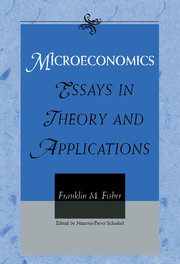Book contents
- Frontmatter
- Contents
- Introduction
- Part I Disequilibrium and Stability
- Part II Welfare Economics and Consumer Theory
- Part III Applications of Microeconomic Theory
- Part IV Industrial Organization, Economics, and the Law
- 24 Organizing Industrial Organization: Reflections on the Handbook of Industrial Organization (1991)
- 25 Reflections on Competition Policy (1993)
- 26 The Social Costs of Monopoly and Regulation: Posner Reconsidered (1985)
- 27 Due Diligence and the Demand for Electricity: A Cautionary Tale (1992)
- 28 Estimating the Effects of Display Bias in Computer Reservation Systems (1990)
- Part V Public Policy Applications
- Epilogue
- Indexes
26 - The Social Costs of Monopoly and Regulation: Posner Reconsidered (1985)
Published online by Cambridge University Press: 20 March 2010
- Frontmatter
- Contents
- Introduction
- Part I Disequilibrium and Stability
- Part II Welfare Economics and Consumer Theory
- Part III Applications of Microeconomic Theory
- Part IV Industrial Organization, Economics, and the Law
- 24 Organizing Industrial Organization: Reflections on the Handbook of Industrial Organization (1991)
- 25 Reflections on Competition Policy (1993)
- 26 The Social Costs of Monopoly and Regulation: Posner Reconsidered (1985)
- 27 Due Diligence and the Demand for Electricity: A Cautionary Tale (1992)
- 28 Estimating the Effects of Display Bias in Computer Reservation Systems (1990)
- Part V Public Policy Applications
- Epilogue
- Indexes
Summary
The traditional analysis of the costs of monopoly concentrates on the deadweight loss involved, monopoly rents being considered merely a transfer to the monopolist from the consumer surplus that would exist under competition. Some years ago, that analysis was challenged by Posner (1975), who presented an ingenious argument that monopoly rents in fact measure the resources lost to society through rent-seeking activities and thus should be counted in the costs of monopoly. That argument has recently been used by staff members of the Federal Trade Commission (Long et al., 1982, Chap. 3, esp. pp. 77, 97, 104; see also Tollison, Higgins, and Shugart, 1983, pp. 23–44) in an attempt to estimate the benefits potentially flowing from the use of the FTC's line-of-business program in antitrust enforcement.
Unfortunately, Posner's argument, while a useful corrective to the traditional proposition that deadweight loss is all that matters, is not correct as a general analysis of the costs of monopoly, and conclusions based on it about the benefits of marginal changes in antitrust activities are likely to be particularly fallacious.
Posner's assumptions and conclusion are as follows:
Obtaining a monopoly is itself a competitive activity, so that, at the margin, the cost of obtaining a monopoly is exactly equal to the expected profit of being a monopolist. An important corollary of this assumption is that there are no intramarginal monopolies – no cases, that is, where the expected profits of monopoly exceed the total supply price of the inputs used to obtain the monopoly.
[…]
- Type
- Chapter
- Information
- MicroeconomicsEssays in Theory and Applications, pp. 404 - 410Publisher: Cambridge University PressPrint publication year: 1999



